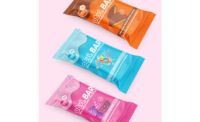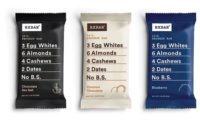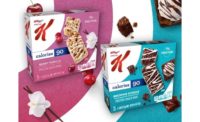Consumers are faced with many options in the snack bar aisle. In response, manufacturers are setting their products apart by offering ‘that little something extra,’
to satisfy the trends to please the foodie in us all.
The bars category covers a lot of ground: Granola bars; energy bars; protein bars; cereal bars; and others populate store shelves these days—and fly off of them. According to market researcher Packaged Facts, Rockville, Md., the retail market for food bars in the U.S. is a staggering $5.7 billion. The firm credits this surge to increased sophistication in marketing, innovations in delivery and a wave of new product launches.
“The bar category is the most overcrowded section in most natural and grocery stores,” states Peter Guam, CEO of Santa Barbara Bars, Santa Barbara, Calif., which launched in May 2013 with three flavors: Coconut Almond; Cranberry White Chocolate; and Peanut Chocolate Cherry. “Yet, the bar industry is in an expanding mode. Not only do we foresee a significant rise in sales within the natural channels, but also especially within the foodservice and convenience store channels. Consumers are increasingly using bars as a meal replacement, as the traditional lunch and dinner consumption changes in the country.” As a result, he explains, shoppers are looking for new textures, flavors, nutritional innovations and compositions, enabling new brands and product lines to emerge, even as the market remains oversaturated.
“The bars industry is growing rapidly,” agrees Denise Day, senior marketing manager at Rudi’s Organic Bakery, Boulder, Colo. “In fact, according to The NPD Group, an estimated 20% of Americans eat some kind of bar each day. The problem, however, is that in a market so crowded, bars—whether they’re of the nutritional, cereal or protein variety—get lumped into one group, both on the shelf and in consumers’ minds.
To address this issue, bar manufacturers are differentiating their products by appealing to two standout trends in the market: Increased protein content; and exciting flavors to appeal to the foodie in us all.
Packing in the protein
As new packaging guidelines spotlight nutrient profiles, consumers are demanding bars with a healthy edge and, specifically, added protein.
“Once considered the go-to food source for endurance and performance athletes, bars touting high protein counts are now increasingly desired items for shoppers across the board,” explains P.J. Roustan, director of marketing at Perfect Bar, San Diego, adding that shoppers are especially looking for alternative protein sources beyond meat and dairy that offer creative flavor and textural combinations. “Heightened satiety, lean muscle mass and increased energy are all key drivers for consuming high-protein diets, not to mention long-lasting fullness and improved skin and bone health.”
Perfect Bar is answering this call with two new recipes for its successful refrigerated, high-protein nutrition bars: Almond Acai Lite; and Almond Coconut. Almond Acai Lite has 33% fewer calories than the company’s original Almond Butter recipe, packing 7 g. of whole-food protein into a 200-calorie bar. Almond Coconut is the company’s first vegan-friendly flavor and is made with a chia-and-hemp protein mix that provides 8 g. of whole-food protein in 260 calories.
Mike Lines, vice president of sales and marketing at Shandiz Natural Foods, Toronto, maker of Taste of Nature bars, reports that in the last six months, his company has been helping both branded and private-label clients develop new high-protein products. “Some of the more notable products include hemp-based protein bars,” he adds, noting that along with poultry, nuts, seeds and peanut butter are the most sought after protein sources.
Cascadian Farm, Minneapolis, launched new organic pea protein bars in January, made with 9 g. of plant-based protein to appeal to this demand. They are available in Peanut Butter Chocolate Chip and Honey Roasted Nut varieties, and like the company’s entire bar portfolio, are U.S. Department of Agriculture (USDA) Certified Organic.
For kids, Clif Bar & Co., Emeryville, Calif., launched Clif Kid Zbar Protein in March. It’s made with pea and whey protein and a blend of rice crisps and toasted organic oats atop a layer of chocolate. It’s available in three kid-friendly flavors: Chocolate Chip; Chocolate Mint; and Peanut Butter Chocolate.
“Consumers like the idea of adding protein to their diet to provide them with fuel and energy for the day, which is why the innovation team at Rudi’s Gluten-Free added 3 g. of protein to each 120-calorie bar,” explains Day. Rudi’s Gluten-Free Cherry Almond Bars, launched January, boast 2 g. of fiber and just 120 calories per bar.
KIND Healthy Snacks, New York, recently announced the release of Strong & Kind, the brand’s first line of savory snack bars with 10 g. of natural protein in each bar. The new line features five unique flavors: Honey Smoked BBQ; Honey Mustard; Roasted Jalapeno; Hickory Smoked; and Thai Sweet Chili. As with other KIND products, the new line is low-sodium and free of gluten, genetically modified organisms (GMO) and monosodium glutamate (MSG).
“I believe one of the reasons for our growth, as well as the growth in the category, is the increasing consumer awareness of the benefits of protein,” echoes Lizanne Falsetto, founder and CEO of Ventura, Calif.-based thinkThin LLC. The company’s 150-calorie, gluten-free Lean Protein & Fiber bars, which hit store shelves in April, each have 20 g. of protein and 5 g. of fiber. “The challenge is not just adding protein, but making it taste good,” she says. To that end, the bars come in classic flavors such as Chocolate Almond Brownie; Chunky Chocolate Peanut; and Cinnamon Bun White Chocolate, as well as on-trend Salted Caramel and Honey Drizzle Peanut.
Still, Falsetto sees education as a barrier to protein’s runaway success with some consumers. “The biggest opportunity is also our biggest challenge: Educating more consumers about the nutrition bar category,” she explains. “A lot of consumers, particularly women, think of our category as protein bars for bodybuilders or energy bars for serious athletes,” she points out, adding that many think they can get nutrition they need from cereal bars, which don’t always deliver the same nutritional value and protein content. “They don’t realize that nutrition bars like thinkThin can help keep you satisfied, help give you energy throughout the day or provide a nutritious alternative to a sweet craving.”
Foodie-friendly flavors
Adventurous consumer palates are driving another key trend in the bars category: Unique flavor profiles.
“Consumers are becoming foodies,” says Michelle Ferguson, executive vice president of marketing at Clif Bar & Co. “They want flavors that excite the palate, such as coconut or macadamia nuts. They also like a combination of textures that they haven’t tried together before.”
Launched March, Clif MOJO Fruit & Nut and Clif MOJO Dark Chocolate bars are available in five flavors: Cranberry Almond; Wild Blueberry Almond; Coconut Almond Peanut; Dark Chocolate Almond Sea Salt; and Dark Chocolate Cherry Almond. They’re gluten-free and crafted with 70% organic ingredients, and have fewer than 200 calories each.
“We’re noticing an increase in salty and sweet flavor profiles, and we’re thrilled to offer our consumers this option with our new Chocolate Peanut Butter with Sea Salt flavor,” says Brandi Shipp, senior vice president of marketing at Skinnygirl Daily, New York. Skinnygirl Tasty Nutrition Bars are also available in Banana Oatmeal Dark Chocolate and Dark Chocolate Multi-Grain Pretzel—another flavor in line with the salty/sweet trend. “The new bars have the same real ingredients, but are now only 150-170 calories and are better tasting, with a whole new look,” adds Shipp.
Packaging standouts
It can be hard to stand out in a crowded category, and there’s no better way for bar manufacturers to differentiate themselves than right on the label.
Perfect Bar recently redesigned its packaging, which Roustan hopes will allow for better competition within the highly aggressive grab-and-go set. “The new packaging includes vibrant, eye-catching colors, offset with ample white space to pop off the shelf,” he says. “Fun illustrations featuring the different flavor recipes highlighted by transparent windows on the wrappers give consumers a sneak peek to the finish product.”
ZEGO, a San Francisco company that launched August 2013, also finds differentiation to be a challenge. “On the marketing side, it’s all noise,” says CEO Colleen Kavanagh. “People are incredibly busy and desensitized to marketing. It’s really hard to get your message heard.”
ZEGO, like Perfect Bar, also finds a solution in packaging—but with a twist. One of its claims to fame is that all of its bars are free of the top eight allergens. When it became clear that there simply wasn’t enough real estate on the wrapper for information about food-allergy testing and control procedures, ZEGO decided to include a QR (Quick Response) code on each wrapper that takes consumers right to the allergen-testing results for the batch from which that bar was made. Consumers can also email the company directly from that link to ask questions about the bar.
“Using this system, we can talk to our customers through our packaging as issues emerge, regardless of when that package was printed,” explains Kavanagh. “For example, say there is an E. coli outbreak involving a particular rice crop. We can update our QR code link to tell our customers the rice in our bars was not part of that crop.”
Partnering for a cause
Andrew Aussie, president and founder of Earnest Eats, Solana Beach, Calif., sees an increase in charitable causes and partnerships to further a brand’s mission. The company, which launched single-serve Superfood Chewy Granola Bars in April, partnered with the International Rescue Committee, which helps refugees worldwide go “from harm to home.” Earnest Eats donates five cents for each bar sold to the charity and calls out this action on the label.
“We have the logo on the front of all our packaging,” says Aussie. “In certain key markets, we do our live demos with their materials. Sometimes, we even work with their refugee clients, bringing a whole new level of immediacy and intimacy to the cause, which has really resonated with both buyers and consumers.”
Overall, the future is bright for the bars category. “Our outlook on snack bars for the future is strong,” Day affirms. “People will continue to seek convenience with bars, and will prefer those bars that are good on-the-go options and made with recognizable ingredients. The better we can serve our customers with a snack bar that is delicious, nutritious and easy for on-the-go, the more smiles we’ll see.”












